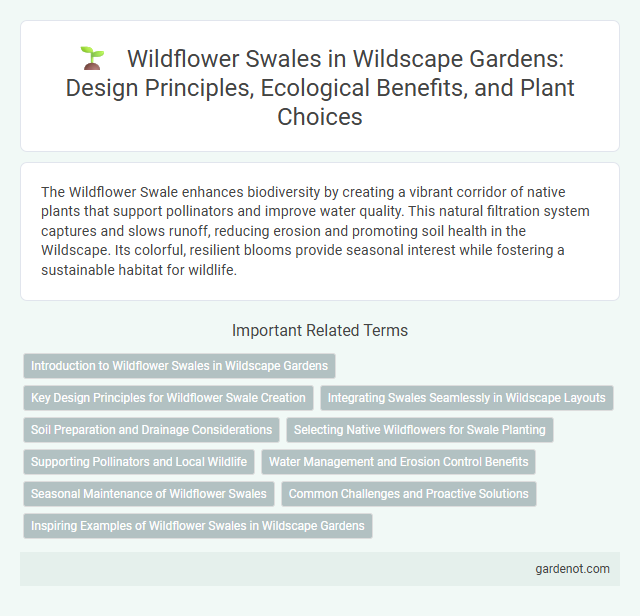The Wildflower Swale enhances biodiversity by creating a vibrant corridor of native plants that support pollinators and improve water quality. This natural filtration system captures and slows runoff, reducing erosion and promoting soil health in the Wildscape. Its colorful, resilient blooms provide seasonal interest while fostering a sustainable habitat for wildlife.
Introduction to Wildflower Swales in Wildscape Gardens
Wildflower swales in Wildscape Gardens serve as natural water management systems that enhance biodiversity by supporting native wildflower species. These swales efficiently capture and filter stormwater, reducing runoff while creating vibrant habitats for pollinators such as bees and butterflies. Integrating wildflower swales promotes ecological balance and sustains the garden's resilient landscape design.
Key Design Principles for Wildflower Swale Creation
Wildflower swale design prioritizes native plant selection to enhance local biodiversity and improve stormwater management through natural filtration and infiltration. Incorporating graded slopes and permeable soil substrates optimizes water retention and supports healthy root systems, promoting erosion control. Strategic placement of diverse wildflower species ensures habitat connectivity and resilience against climate variability.
Integrating Swales Seamlessly in Wildscape Layouts
Wildflower swales enhance Wildscape layouts by naturally managing stormwater while supporting biodiversity through native plant species. Carefully designed swales promote infiltration, reduce runoff, and create habitat corridors that integrate seamlessly with surrounding wildscape elements. Strategic placement and native plant selection ensure swales complement the overall ecosystem, improving both function and aesthetic appeal.
Soil Preparation and Drainage Considerations
Soil preparation for a wildflower swale involves deep tilling and amending with organic matter to enhance nutrient availability and soil structure, promoting healthy root growth. Proper drainage is essential to prevent waterlogging, achieved by grading the swale to direct runoff evenly and incorporating permeable substrates like sand or gravel to facilitate infiltration. Maintaining optimal moisture levels supports wildflower establishment while preventing erosion and runoff.
Selecting Native Wildflowers for Swale Planting
Selecting native wildflowers for swale planting enhances soil stabilization and boosts local biodiversity by providing habitat for pollinators. Species such as Echinacea purpurea, Asclepias tuberosa, and Rudbeckia hirta thrive in wet conditions typical of swales, ensuring effective water absorption and erosion control. Incorporating a diverse mix of flowering times supports resilient ecosystems and continuous seasonal ecological benefits.
Supporting Pollinators and Local Wildlife
Wildflower swales play a crucial role in supporting pollinators such as bees, butterflies, and hummingbirds by providing diverse nectar sources and habitat. These swales enhance local biodiversity, offering shelter and breeding grounds for various insects and small wildlife. Their native plant composition helps maintain ecological balance and promotes healthy ecosystems in urban and rural landscapes.
Water Management and Erosion Control Benefits
Wildflower swales significantly enhance water management by facilitating natural rainwater infiltration and reducing surface runoff, promoting groundwater recharge. Their dense vegetation stabilizes soil, effectively preventing erosion and minimizing sediment transport in surrounding areas. These ecological features contribute to sustainable landscape design by improving water quality and preserving soil integrity.
Seasonal Maintenance of Wildflower Swales
Seasonal maintenance of wildflower swales involves regular monitoring to ensure optimal plant health and soil stability. This includes mowing or selective trimming in late summer to prevent invasive species from dominating and to promote native wildflower regeneration. Periodic removal of accumulated debris and reseeding with native wildflower species enhances biodiversity and maintains effective stormwater infiltration.
Common Challenges and Proactive Solutions
Wildflower swales often face common challenges such as invasive species infiltration, poor soil drainage, and inconsistent pollinator presence, which can hinder plant growth and biodiversity. Proactive solutions include regular monitoring and removal of invasive plants, enhancing soil structure through organic amendments, and planting a diverse mix of native wildflowers to attract and sustain pollinators. Implementing controlled watering schedules and installing erosion control measures further supports the long-term health and resilience of wildflower swales in wildscapes.
Inspiring Examples of Wildflower Swales in Wildscape Gardens
Wildflower swales in Wildscape gardens serve as vibrant, eco-friendly water management systems that enhance biodiversity and support pollinators. These swales use native wildflowers to naturally filter stormwater, reduce runoff, and create habitats for birds, bees, and butterflies. Examples like the Chicago Botanic Garden and the Lady Bird Johnson Wildflower Center demonstrate successful integration of wildflower swales that promote ecological resilience and aesthetic beauty.
Wildflower swale Infographic

 gardenot.com
gardenot.com